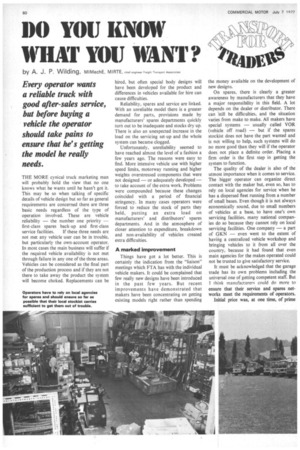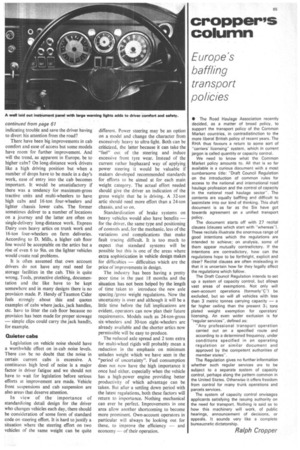1)0 YOU KNOW 10fl WHAT YOII WANT? lki D ov by A.
Page 62

Page 63

Page 67

If you've noticed an error in this article please click here to report it so we can fix it.
J. P. Wilding, MIMechE, MI RTE, chief engineer Freight Transport Association
Every operator wants a reliable truck with good after-sales service, but before buying a vehicle the operator should take pains to ensure that he's getting the model he really needs.
THE MORE cynical truck marketing man will probably hold the view that no one knows what he wants until he hasn't got it. This may be so when talking of specific details of vehicle design but so far as general requirements are concerned there are three basic needs regardless of the type of operation involved. These are vehicle reliability — the number one priority — first-class spares back-up and first-class service facilities. If these three needs are not met any vehicle user can be in trouble, but particularly the own-account operator. In most cases the main business will suffer if the required vehicle availability is not met through failure in any one of the three areas. Vehicles can be considered as the final part of the production process and if they are not there to take away the product the system will become choked. Replacements can be hired, but often special body designs will have been developed for the product and differences in vehicles available for hire can cause difficulties.
Reliability, spares and service are linked. With an unreliable model there is a greater demand for parts, provisions made by manufacturers' spares departments quickly turn out to be inadequate and stocks dry up. There is also an unexpected increase in the load on the servicing set-up and the whole system can became clogged.
Unfortunately, unreliability seemed to have reached almost the level of a fashion a few years ago. The reasons were easy to find. More intensive vehicle use with higher speed limits, motorway running and higher weights overstressed components that were not designed — or adequately developed — to take account of the extra work. Problems were compounded because these changes coincided with a period of financial stringency. In many cases operators were forced to reduce the stock of parts they held, putting an extra load on manufacturers' and distributors' spares departments. And in the atmosphere of closer attention to expenditure, breakdown and non-availability of vehicles created extra difficulties.
A marked improvement Things have got a lot better. This is certainly the indication from the "liaison" meetings which FTA has with the individual vehicle makers. It could be complained that few really new designs have been introduced in the past few years. But recent improvements have demonstrated that makers have been concentrating on getting existing models right rather than spending the money available on the development of new designs.
On spares, there is clearly a greater awareness by manufacturers that they have a major responsibility in this field. A lot depends on the dealer or distributor. There can still be difficulties, and the situation varies from make to make. All makers have special systems — usually called VOR (vehicle off road) — but if the spares stockist does not have the part wanted and is not willing to help, such systems will do no more good than they will if the operator does not place a definite order. Placing a firm order is the first step in getting the system to function.
The quality of the dealer is also of the utmost importance when it comes to service. The bigger operator can organize direct contact with the maker but, even so, has to rely on local agencies for service when he has a dispersed fleet running from a number of small bases. Even though it is not always economically sound, due to small numbers of vehicles at a base, to have one's own servicing facilities, many national companies do so because they cannot rely on local servicing facilities. One company — a part of GKN — even went to the extent of having a centralized vehicle workshop and bringing vehicles to it from all over the country, because it had found that even main agencies for the makes operated could not be trusted to give satisfactory service.
It must be acknowledged that the garage trade has its own problems including the universal one of getting competent staff. But
think manufacturers could do more to ensure that their service and spares networks meet the requirements of operators.
Initial price was, at one time, of prime mportance when deciding the vehicle to )uy. This is not so much the case now. :here are many operators, particularly in he own-account field, who base the buying recision on the total costs during a vehicle's ife. Obviously the purchase price is mportant but it is necessary also to take .ccount of maintenance and servicing costs, otal life expectancy, possible costs when 'chides are not available because of inscheduled repairs (unreliability) and so E. Farley of Tate and Lyle made this paint at an FTA seminar in London last nonth and he also stressed the value of .ssessing a model thoroughly by actually iperating a demonstration vehicle. But Mr 7arley had also investigated the availability if demonstrators from the various nanufacturers and this had shown that it is lot always possible to obtain the model lceded.
Obtaining the right demonstration vehicle an certainly be a problem in the min-account field, especially when the lodywork has to suit the product carried. )n the other hand, the own-account man as the advantage of knowing relatively .ccurately the use to which his vehicles will le put and the goods they will be carrying. ie can tailor the vehicles for the particular Db and knows that they will, for the most 'art, be returning to their base depot each .ight.
Drivers in own-account fleets are more kely to change around among vehicles han in haulage and in the view of both R. )uncalfe of RHM Foods and I. Malin of rlobil Oil there should be more effort to tandardizc instrument layouts in cabs now hat there is an even greater need for a man 3 concentrate on his driving in present-day oad conditions. There is a strong case for luch rethinking on instrumentation. Can he driver be expected to notice a low eading on a small gauge which is never in he same location from one vehicle to the ext? Would it not be better to make larger varning lights serve the main purpose of
indicating trouble and save the driver having to divert his attention from the road?
There have been big improvements in cab comfort and ease of access but some models have room for further improvement. And will the trend, as apparent in Europe, be to higher cabs? On long-distance work drivers like a high driving position but when a number of drops have to be made in a day's work, ease of entry into the cab becomes important. It would be unsatisfactory if there was a tendency for maximum-gross tractive units and multi-wheelers to have high cabs and 16-ton four-wheelers and lighter chassis lower cabs. The former sometimes deliver to a number of locations on a journey and the latter are often on single-delivery long-distance work. Express Dairy uses heavy artics on trunk work and 16-ton four-wheelers on farm deliveries. According to D. Mills, a higher cab floor line would be acceptable on the artics but a rise of even 6 to 9in. on the lighter vehicles would create real problems.
It is often assumed that own account drivers do not have any real need for storage facilities in the cab. This is quite wrong. Tools, protective clothing, documentation and the like have to• be kept somewhere and in many designs there is no provision made. P. Hendy of Taunton Cider feels strongly about this and quotes examples of cabs where jacks, jack handles, etc. have to litter the cab floor because no provision has been made for proper stowage — simple clips could carry the jack handle, for example.
Quieter cabs Legislation on vehicle noise should have a worthwhile effect on in-cab noise levels. There can be no doubt that the noise in certain current cabs is excessive. A continuous high level of noise is a major factor in driver fatigue and we should not have to wait for legislation before serious efforts at improvement are made. Vehicle front suspensions and cab suspension are also areas that deserve attention.
In view of the importance of standardizing detail design for the driver who changes vehicles each day, there should be consideration of some form of standard code on steering effort. It is hard to justify a situation where the steering effort on two vehicles of the same weight can be quite
different. Power steering may be an option on a model and change the character from excessively heavy to ultra-light. Both can be criticized, the latter because it can take the "feel" out of the steering and induce excessive front tyre wear. Instead of the current rather haphazard way of applying power steering it would be valuable if makers developed recommended standards for efforts to be aimed at for each main weight category. The actual effort needed should give the driver an indication of the gross weight that he is driving. A 32-ton artie should need more effort than a 24-ton chassis. and so on.
Standardization of brake systems on heavy vehicles would also have benefits — for the driver, the same type and positioning of controls and, for the mechanic, less of the variations and complications that make fault tracing difficult. It is too much to expect that standard systems will be possible but this is one of the areas where extra sophistication in vehicle design makes for difficulties — difficulties which are the price of improvements in design.
The industry has been having a pretty poor time in the past 18 months and the situation has not been helped by the length of time taken to introduce the new axle spacing /gross weight regulations. Now the uncertainty is over and although it will be a little time before the full implications are evident, operators can now plan their future requirements. Models such as 24-ton-gross six-wheelers and 30-ton eight-wheelers are already available and the shorter artics now permissible will be easy to produce.
The reduced axle spread and 2 tons extra for multi-wheel rigids will probably mean a reduction in the emphasis on minimum unladen weight which we have seen in the "period of uncertainty": Fuel consumption does not now have the high importance it once had either, especially when the vehicle has a high-power engine providing better productivity of which advantage can be taken. But after a settling down period with the latest regulations, both these factors will return to importance. Nothing mechanical can ever be perfect. Improvements in one area allow another shortcoming to become more prominent. Own-account operators in particular will always be looking out for these, to improve the efficiency — and economy — of their operation.
















































































































































